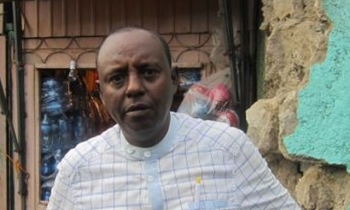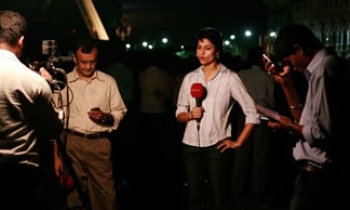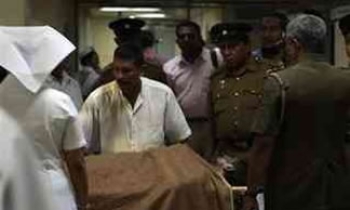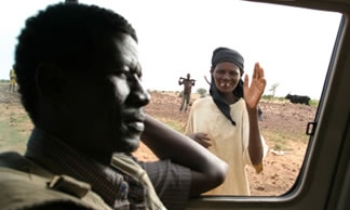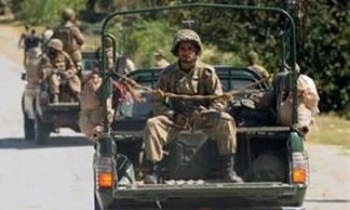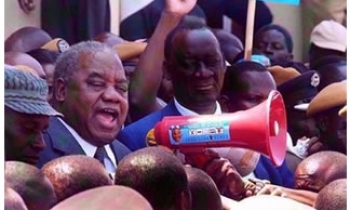The brutal murder of a young journalist near the capital town of Dhaka has once again brought to light why Bangladesh remains the most dangerous place for a journalist to be in the world next to Iraq. Bangladesh was ranked 151 by Reporters sans Frontières (RSF) in its Worldwide Press Freedom Index 2005.
 HEADLINES TODAY: A youth reads a daily at a roadside vendor in Dhaka. Journalists in Bangladesh admit their profession is not always practised for the right reasons. Businessmen often start newspapers simply to gain access to the corridors of power; there are 130 dailies in Dhaka alone. Corruption is everywhere – Transparency International ranked Bangladesh bottom of its global corruption index in each of the past five years – and journalism is no exception. (Rafiqur Rahman/Reuters)
HEADLINES TODAY: A youth reads a daily at a roadside vendor in Dhaka. Journalists in Bangladesh admit their profession is not always practised for the right reasons. Businessmen often start newspapers simply to gain access to the corridors of power; there are 130 dailies in Dhaka alone. Corruption is everywhere – Transparency International ranked Bangladesh bottom of its global corruption index in each of the past five years – and journalism is no exception. (Rafiqur Rahman/Reuters)Gautam Das, correspondent for national newspaper Dainik Samakal, was found dead at his office in Faridpur on November 17. First reports from the murder scene said that his arms and legs had been broken, and his neck bore the marks of blows. A post mortem has been held but the results are yet to be made public.
A nylon string was used as a noose to kill him. The top of rope with running knots was found wrapped around his neck. His hands and legs were also lightly bound. It is assumed that the killers having killed Das fled the spot autolocking the door from outside. Finding the office room closed his friends informed the police who rushed to the spot, broke open the door, and recovered the body.
"The impunity that exists in Bangladesh encourages criminals to continue to strike at journalists who expose their misdeeds. We are revolted by the murder of this young journalist, who knew his life was at risk, but continued despite this to do his job," said Paris-based press freedom organisation Reporters sans Frontières (RSF).
RSF called on the authorities, in particular the police, to carry out an exhaustive and impartial investigation. Das, a former correspondent on the daily Prothom Alo, specialised in investigations into illegal activities and abuse of power on the part of certain public figures in Faridpur. He had recently written articles about drug-trafficking in the region.
His newspaper, which was recently launched at national level, was already respected for its uncompromising investigations in one of the world's most corrupt countries. Das, who came from a poor family, was highly respected by his colleagues. Das, 28, is the second journalist to be murdered in Bangladesh in 2005. Nine journalists have been murdered in the country because of their work since 2000.
RSF says politicians from both sides accuse the media of trying to destabilise the country through their reporting. Over the past few years, the government has been particularly critical of both domestic and foreign reporting about signs of Islamic extremists operating in the country.
 GLOSSING OVER: Despite denials from Prime Minister Begum Khaleda Zia, Islamic militancy in Bangladesh is on the rise, and journalists reporting on the trend are increasingly at risk. The government has previously accused journalists of inventing stories about militant groups, but newspapers investigations over the last two years have uncovered connections between outlawed groups and al-Qaeda. (Reuters/Desmond Boylan)
GLOSSING OVER: Despite denials from Prime Minister Begum Khaleda Zia, Islamic militancy in Bangladesh is on the rise, and journalists reporting on the trend are increasingly at risk. The government has previously accused journalists of inventing stories about militant groups, but newspapers investigations over the last two years have uncovered connections between outlawed groups and al-Qaeda. (Reuters/Desmond Boylan)"It's very ironic. You find that whenever you find that these politicians are in the opposition, they advise us to become more bold, courageous and very free," the head of the Bangladesh Federal Union of Journalists (BFUJ), Iqbal Sobhan Chowdhury, was quoted as saying in a recent report by the Voice of America (VOA). "But whenever they go to power, they advise us to restrain ourselves to become objective�. You can call it sweet and sour relations between the politicians, the rulers and the journalist community."
Journalists in Bangladesh are regularly threatened or eventually killed by criminal gangs and Islamic fundmentalists.
In September this year, Islamic militants threatened to kill nine journalists in southern Bangladesh unless they stopped reporting on the activities of three groups calling for the establishment of an Islamic state through "armed revolution." Pieces of white cloth symbolising a funeral shroud were mailed to the journalists in the city of Satkhira on September 4 along with letters signed by the outlawed Islamic militant group Bangla Bhai, the radical movement Ahle Hadith, and the Islamic political party Jamaat-i-Islami, a partner of the ruling Bangladesh Nationalist Party (BNP) in parliament. Local press reports said the letter warned the journalists not to write about the militants' activities and threatened to kill Hindus reporting on Islamic groups.
Sheikh Belaluddin, a correspondent with the Bengali-language daily Sangram, died on February 10 this year of injuries suffered in a bomb attack five days earlier. Belaluddin was injured along with three other journalists on February 5, when a bomb exploded at a press club in Khulna. The bomb, which was hidden in a bag hanging from a motorcycle detonated as Belaluddin approached the vehicle.
On January 15, 2004, senior investigative reporter Manik Saha was alsobrutally murdered by a homemade bomb thrown at him in broad daylight. Saha, a correspondent for the English-language daily New Age and a stringer for the BBC, had a reputation for bold reporting on local criminal gangs and drug smugglers. His death shocked the journalism community and the country. Prime Minister Khaleda Zia pledged to track down and punish those behind the killing.
An underground leftist group, Janajuddha (People's War), a faction of the outlawed Purbo Banglar Communist Party (PBCP), claimed responsibility for Saha's murder the day after he died. In the following weeks, the PBCP threatened to kill as many as 20 other local journalists in a similar fashion unless they stopped reporting about Saha's killing and the group's criminal activities.
 ANGRY: Journalists protesting the murder of Manik Saha, a correspondent for the daily New Age and the BBC World Service. Saha was killed on January 25, 2004 when a homemade bomb was thrown at him as he was travelling on a scooter. He had been under threat as a result of his reports about the illegal activities of local criminal gangs. Several suspects detained by the police in April called Saha an "enemy of the proletariat.(Reuters/Mohammad Shahidullah)
ANGRY: Journalists protesting the murder of Manik Saha, a correspondent for the daily New Age and the BBC World Service. Saha was killed on January 25, 2004 when a homemade bomb was thrown at him as he was travelling on a scooter. He had been under threat as a result of his reports about the illegal activities of local criminal gangs. Several suspects detained by the police in April called Saha an "enemy of the proletariat.(Reuters/Mohammad Shahidullah)On June 27, 2004, Humayun Kabir, another well-known journalist who edited the Bangla-language daily Janmabhumi (Motherland), was murdered in a similar bomb attack in Khulna. Kabir was president of the Khulna Press Club and had published articles exposing local organised crime. Janajuddha also claimed responsibility for his death. The BBC reported that nine suspects were detained in connection with Kabir's murder, but local journalists remain sceptical about the case being resolved because the suspects have not been convincingly linked to Janajuddha.
Kamal Hossain, was abducted and brutally murdered in August 2004 in the southeastern Chittagong district in retaliation for his investigative reporting on local criminal groups for the Bangla-language daily Ajker Kagoj. Unidentified assailants kidnapped Hossain's 2-year-old son, holding him until the journalist surrendered and was taken away at gunpoint on August 21. Hossain's decapitated body was found near his house the next day; his wife told local reporters that he had received death threats in the weeks leading up to the attack.
Journalists murdered in Bangladesh since 2000:
- Mir Illias Hossain, Dainik Bir Darpan, January 15, 2000, Jhenaidah
- Shamsur Rahman, Janakantha, July 16, 2000, Jessore
- Nahar Ali, Anirban, April 21, 2001, Khulna
- Harunur Rashid, Dainik Purbanchal, March 2, 2002, Khulna
- Shukur Hossain, Anirban, July 5, 2002, Ula
- Manik Saha, New Age, January 15, 2004, Khulna
- Humayun Kabir, Janmabhumi, June 27, 2004, Khulna
- Kamal Hossain, Ajker Kagoj, August 22, 2004, Manikcchari
- Sheikh Belaluddin, Sangram, February 11, 2005, Dhaka
- Gautam Das, Dainik Samakal, November 17, 2005, Faridpur

